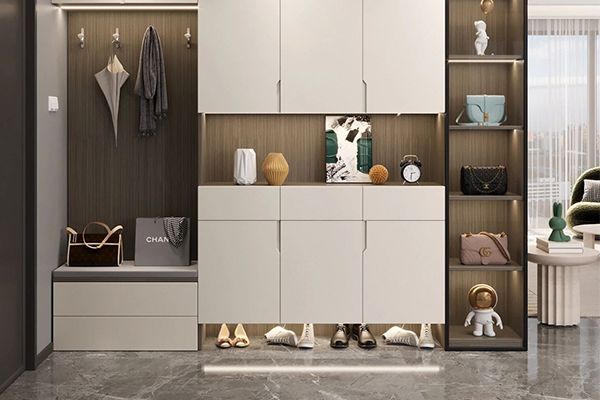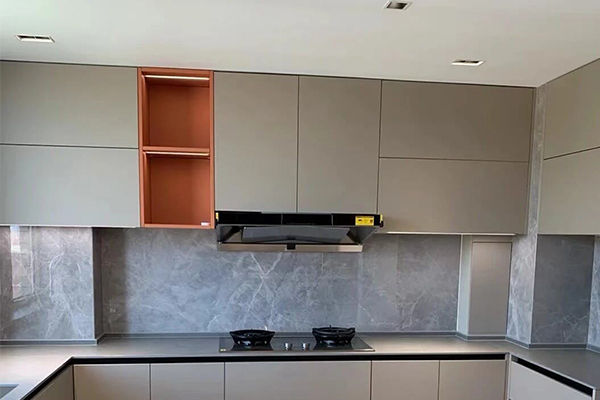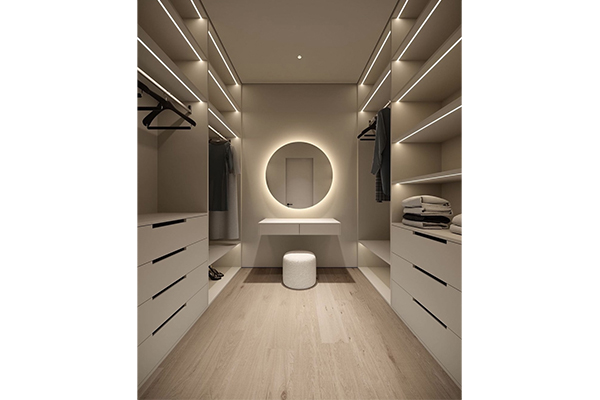How to maximize the use of space in the design of shoe cabinets?
Release Time : 2025-07-21
In modern home spaces, storage and tidiness have become one of the important criteria for measuring living quality. As an important piece of furniture at the entrance of a home, the rationality of the design of the shoe cabinet directly affects the utilization rate of space and the convenience of use. A well-designed shoe cabinet can not only accommodate a large number of shoes, but also achieve efficient use of space through clever structural layout, so that limited space can play the maximum storage value.
The space optimization of the shoe cabinet is first reflected in the modular and hierarchical design of the structure. Traditional shoe cabinets often use fixed shelves, which are difficult to adapt to the needs of different shoe types, resulting in space waste. Modern shoe cabinets take full account of the diversity of shoe types in design, and adopt various forms such as adjustable shelves, drawer-type structures, and flip door designs to make the internal space more flexible. For example, by setting up movable partitions, users can freely adjust the spacing between shelves according to the height of the shoes, which can accommodate high boots and neatly place flat shoes, thereby avoiding idle space. At the same time, some shoe cabinets reserve an open area at the bottom for placing frequently worn shoes, which is convenient for access and reduces the trouble of frequent opening and closing of the cabinet door.
Secondly, shoe cabinets show extremely high efficiency in the use of vertical space. Many families have limited entrance areas. If the traditional horizontally expanded cabinet design is adopted, it is easy to cause space congestion. Modern shoe cabinets focus on upward development, make full use of the wall height, and design a multi-layer structure. Through reasonable height distribution, shoe cabinets can not only accommodate more shoes on a limited ground, but also store uncommon shoes in the top area, and frequently used shoes in the middle or lower part, making space utilization more scientific. In addition, some shoe cabinets also combine functions such as seats and shoe-changing benches, combining storage with practicality, so that every inch of space is fully utilized.
Furthermore, the detailed design of shoe cabinets also plays a key role in improving space utilization. For example, the use of double-door or folding door design not only saves the space required for opening the door, but also allows the cabinet to be more compactly embedded in the wall or corner. At the same time, some shoe cabinets have hidden storage compartments or hooks on the inside of the door for storing small items such as shoe brushes, shoelaces, socks, etc., which further improves the storage efficiency. In addition, some high-end shoe cabinets have also introduced the design of rotating shoe racks or sliding drawers, so that users can easily take and put shoes without bending over, which not only improves the convenience of use, but also effectively utilizes the corner space inside the cabinet.
It is worth mentioning that while the shoe cabinet is integrated with the overall home style, it also takes into account the visual neatness of the space. Many shoe cabinets adopt embedded or wall-mounted designs to integrate them with the wall and floor to avoid abruptness. The design of the cabinet surface is also becoming more and more diversified, such as the use of mirrors, glass, wood grain, metal and other materials, which can not only improve the aesthetics, but also reflect light and enhance the transparency of the space. The use of this "invisible storage" concept allows the shoe cabinet to meet the storage needs while not making the entrance look messy, but instead improves the neatness and beauty of the overall space.
In addition, the ventilation and partition design of the shoe cabinet also indirectly improves the space utilization rate. Reasonable ventilation structure can not only keep the air in the cabinet flowing and prevent odor accumulation, but also extend the service life of shoes. Some shoe cabinets are designed with air holes at the back or bottom of the cabinet, or use hollow structures to allow air to circulate naturally and reduce the problem of mildew caused by humidity. At the same time, by setting up different functional partitions, such as areas for storing sports shoes, leather shoes, and slippers, the shoes can be classified in order, and the access is faster, which also avoids the waste of space caused by messy placement.
Finally, the customization trend of shoe cabinets also provides more possibilities for space utilization. Different families have different entrance structures, usage habits and storage needs, and standardized products are often difficult to fully meet. Customized shoe cabinets can be personalized according to the size of the space, the number of family members, and the types of shoes to ensure that every inch of space is fully utilized. Whether it is an L-shaped corner layout, a hanging design, or an integrated combination of shoe-changing benches, umbrella racks, key storage and other functions, it can be flexibly adjusted according to actual needs to truly achieve "tailor-made".
In summary, the shoe cabinet design achieves maximum space utilization through modular structure, vertical space utilization, detail optimization, style integration, ventilation partition and customized services. It not only improves storage efficiency, but also optimizes the cleanliness and beauty of the home environment, providing modern families with efficient, convenient and beautiful storage solutions. With the continuous advancement of design concepts, the future shoe cabinet will show more innovations in space utilization, creating a more comfortable and orderly living experience for people.
The space optimization of the shoe cabinet is first reflected in the modular and hierarchical design of the structure. Traditional shoe cabinets often use fixed shelves, which are difficult to adapt to the needs of different shoe types, resulting in space waste. Modern shoe cabinets take full account of the diversity of shoe types in design, and adopt various forms such as adjustable shelves, drawer-type structures, and flip door designs to make the internal space more flexible. For example, by setting up movable partitions, users can freely adjust the spacing between shelves according to the height of the shoes, which can accommodate high boots and neatly place flat shoes, thereby avoiding idle space. At the same time, some shoe cabinets reserve an open area at the bottom for placing frequently worn shoes, which is convenient for access and reduces the trouble of frequent opening and closing of the cabinet door.
Secondly, shoe cabinets show extremely high efficiency in the use of vertical space. Many families have limited entrance areas. If the traditional horizontally expanded cabinet design is adopted, it is easy to cause space congestion. Modern shoe cabinets focus on upward development, make full use of the wall height, and design a multi-layer structure. Through reasonable height distribution, shoe cabinets can not only accommodate more shoes on a limited ground, but also store uncommon shoes in the top area, and frequently used shoes in the middle or lower part, making space utilization more scientific. In addition, some shoe cabinets also combine functions such as seats and shoe-changing benches, combining storage with practicality, so that every inch of space is fully utilized.
Furthermore, the detailed design of shoe cabinets also plays a key role in improving space utilization. For example, the use of double-door or folding door design not only saves the space required for opening the door, but also allows the cabinet to be more compactly embedded in the wall or corner. At the same time, some shoe cabinets have hidden storage compartments or hooks on the inside of the door for storing small items such as shoe brushes, shoelaces, socks, etc., which further improves the storage efficiency. In addition, some high-end shoe cabinets have also introduced the design of rotating shoe racks or sliding drawers, so that users can easily take and put shoes without bending over, which not only improves the convenience of use, but also effectively utilizes the corner space inside the cabinet.
It is worth mentioning that while the shoe cabinet is integrated with the overall home style, it also takes into account the visual neatness of the space. Many shoe cabinets adopt embedded or wall-mounted designs to integrate them with the wall and floor to avoid abruptness. The design of the cabinet surface is also becoming more and more diversified, such as the use of mirrors, glass, wood grain, metal and other materials, which can not only improve the aesthetics, but also reflect light and enhance the transparency of the space. The use of this "invisible storage" concept allows the shoe cabinet to meet the storage needs while not making the entrance look messy, but instead improves the neatness and beauty of the overall space.
In addition, the ventilation and partition design of the shoe cabinet also indirectly improves the space utilization rate. Reasonable ventilation structure can not only keep the air in the cabinet flowing and prevent odor accumulation, but also extend the service life of shoes. Some shoe cabinets are designed with air holes at the back or bottom of the cabinet, or use hollow structures to allow air to circulate naturally and reduce the problem of mildew caused by humidity. At the same time, by setting up different functional partitions, such as areas for storing sports shoes, leather shoes, and slippers, the shoes can be classified in order, and the access is faster, which also avoids the waste of space caused by messy placement.
Finally, the customization trend of shoe cabinets also provides more possibilities for space utilization. Different families have different entrance structures, usage habits and storage needs, and standardized products are often difficult to fully meet. Customized shoe cabinets can be personalized according to the size of the space, the number of family members, and the types of shoes to ensure that every inch of space is fully utilized. Whether it is an L-shaped corner layout, a hanging design, or an integrated combination of shoe-changing benches, umbrella racks, key storage and other functions, it can be flexibly adjusted according to actual needs to truly achieve "tailor-made".
In summary, the shoe cabinet design achieves maximum space utilization through modular structure, vertical space utilization, detail optimization, style integration, ventilation partition and customized services. It not only improves storage efficiency, but also optimizes the cleanliness and beauty of the home environment, providing modern families with efficient, convenient and beautiful storage solutions. With the continuous advancement of design concepts, the future shoe cabinet will show more innovations in space utilization, creating a more comfortable and orderly living experience for people.







